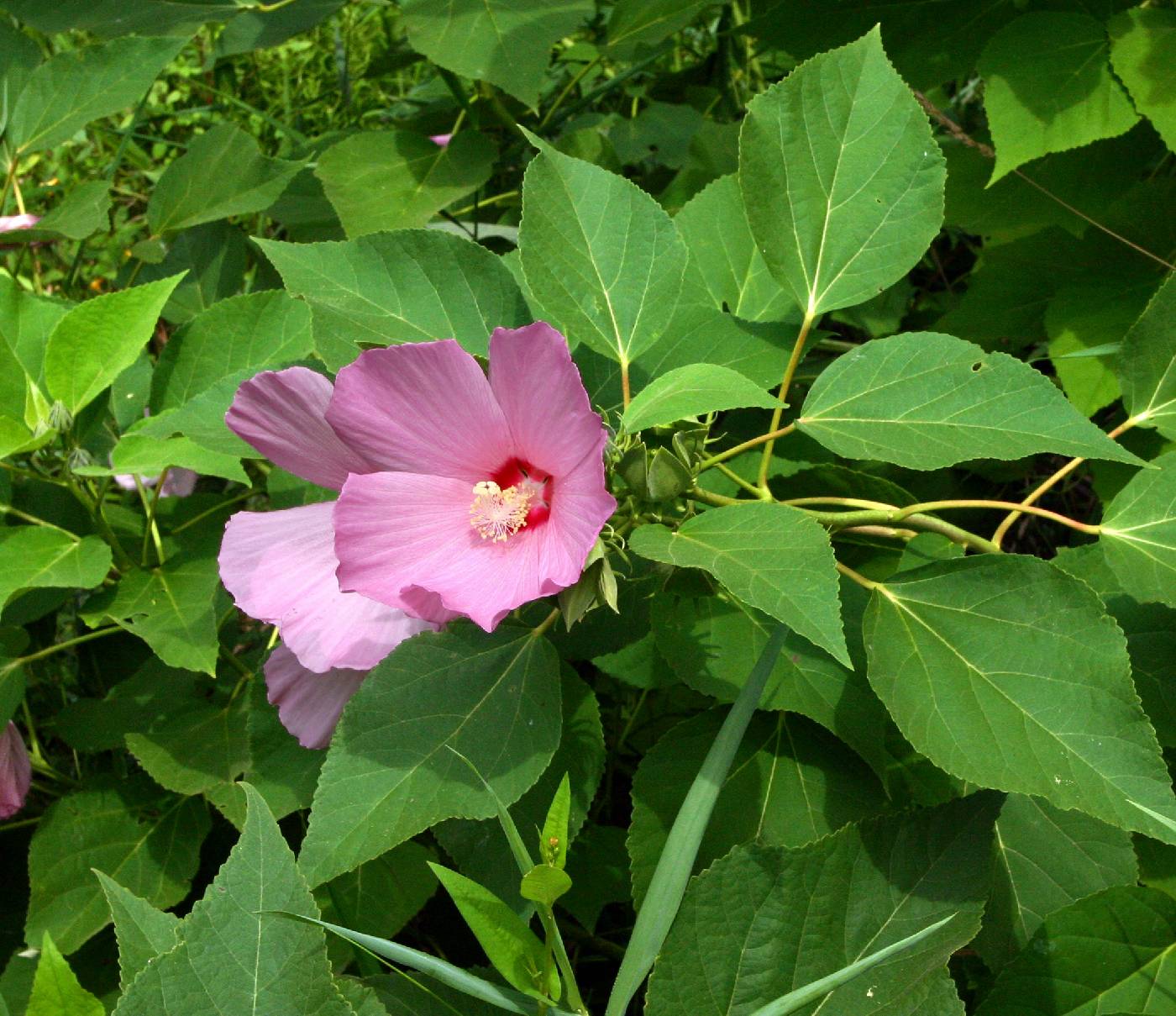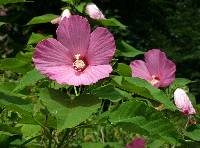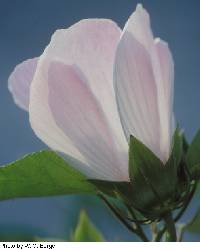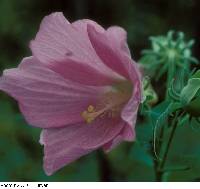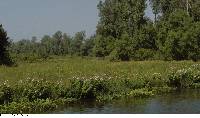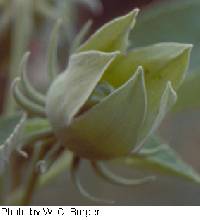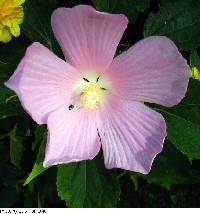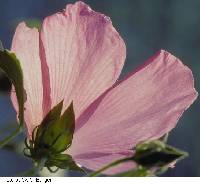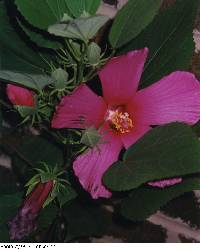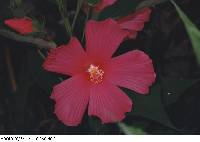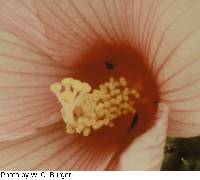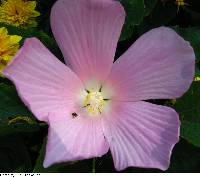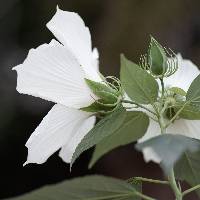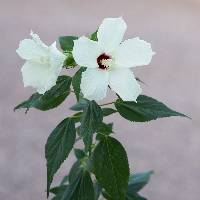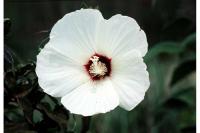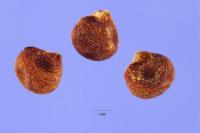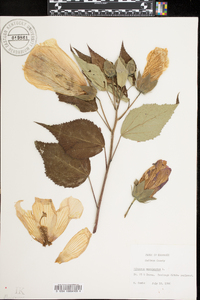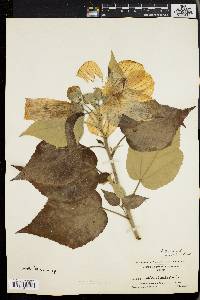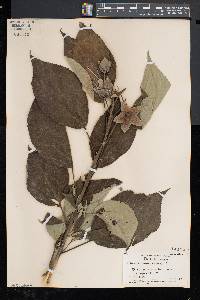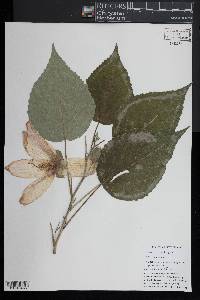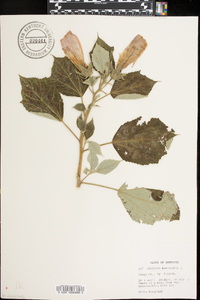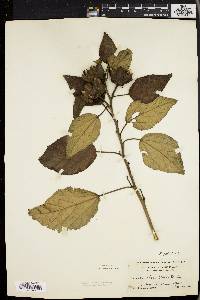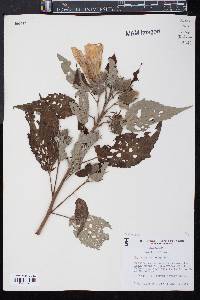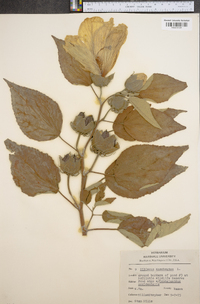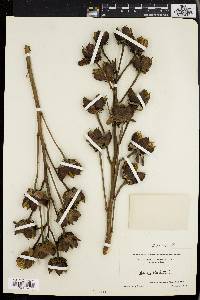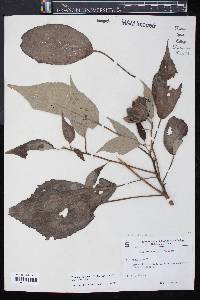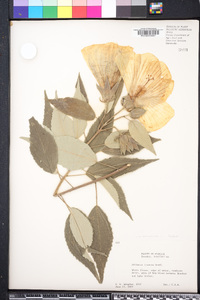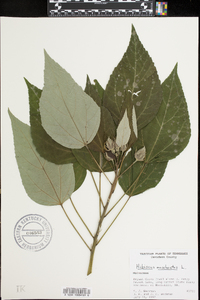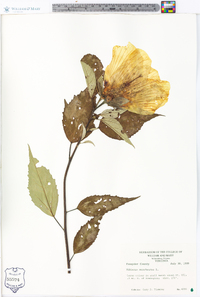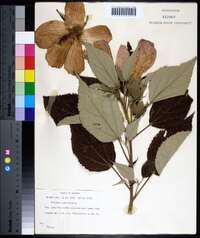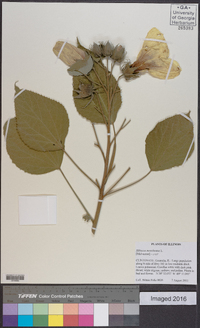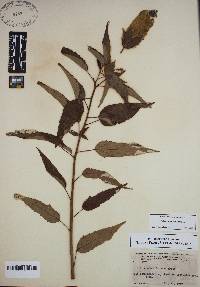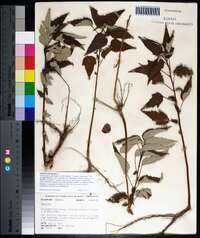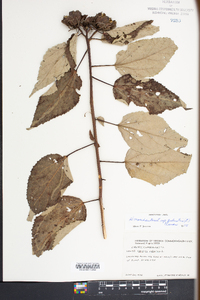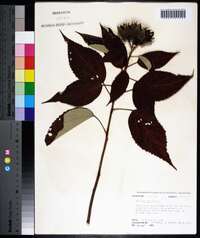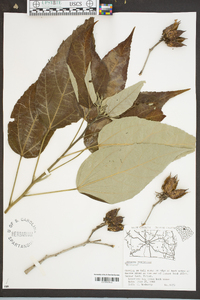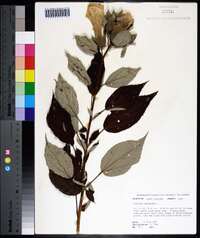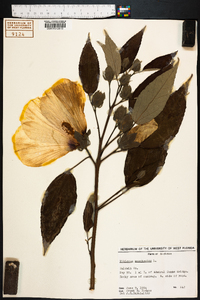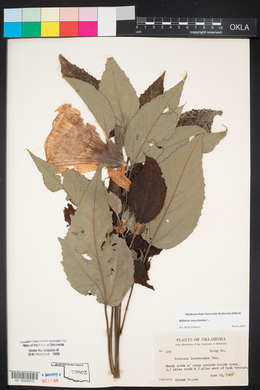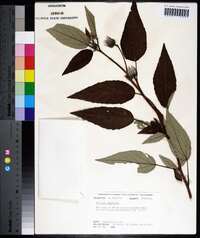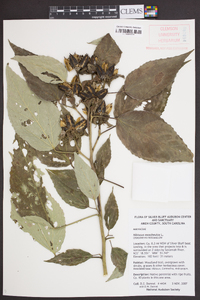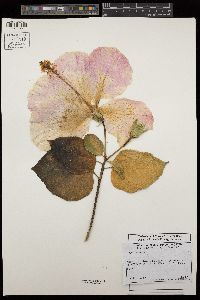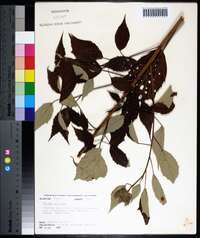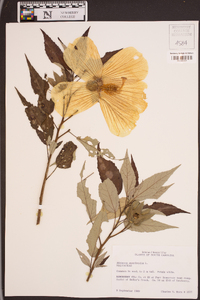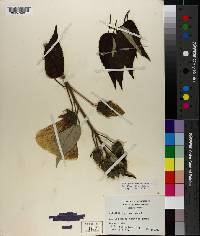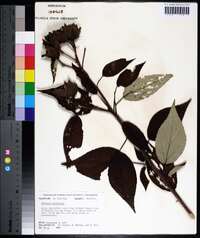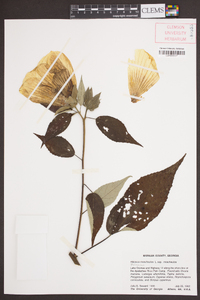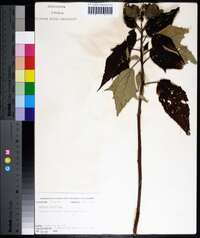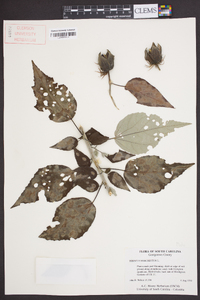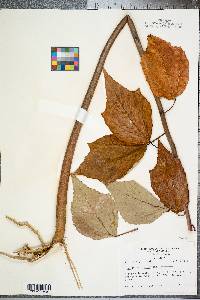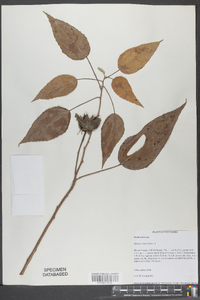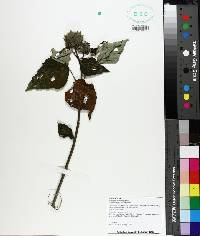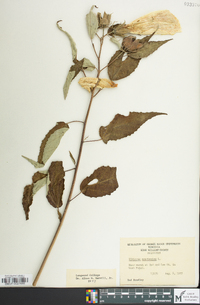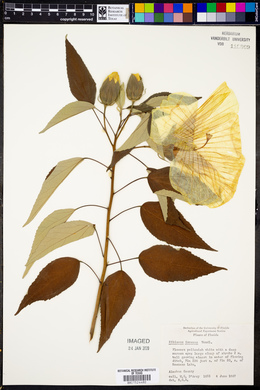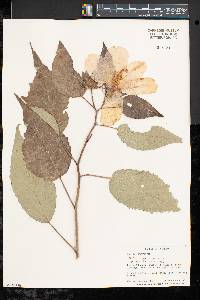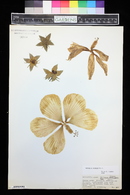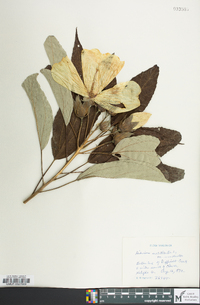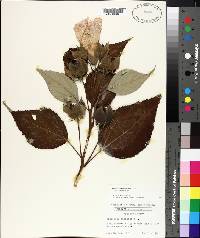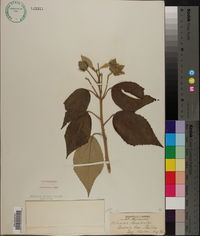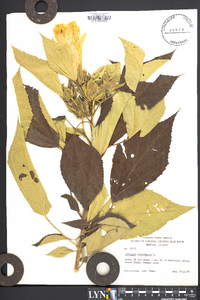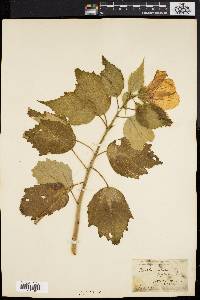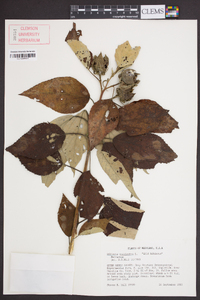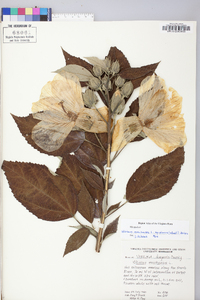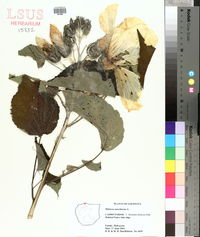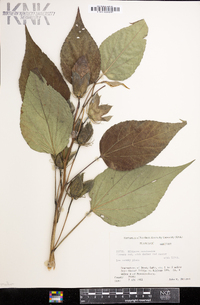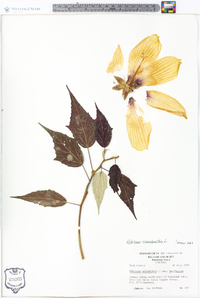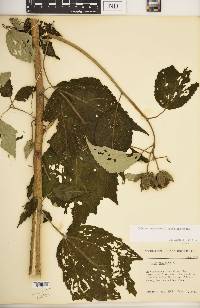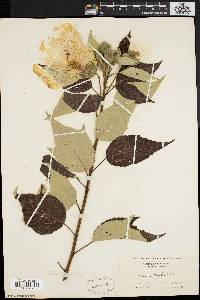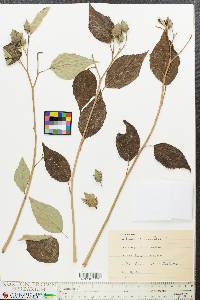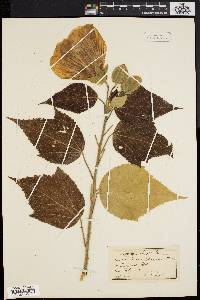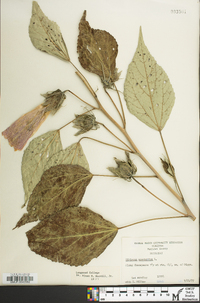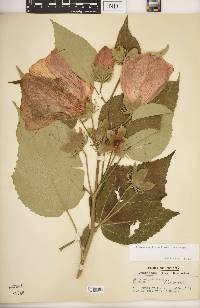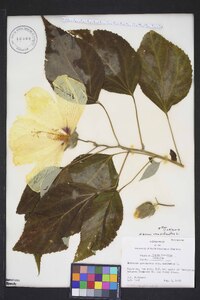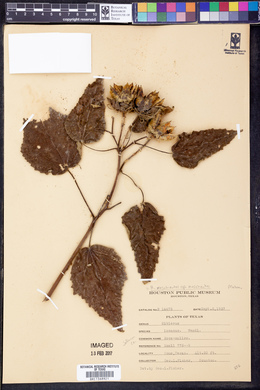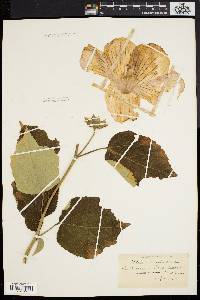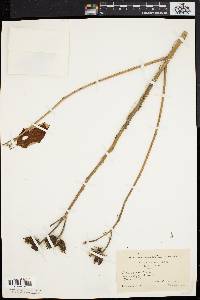
|
|
|
|
Family: Malvaceae
Crimson-Eye Rose-Mallow, more...mallow rose, swamp rose mallow, crimsoneyed rosemallow
[Hibiscus incanus J.C.Wendl., moreHibiscus moscheutos subsp. incanus (Wendl) H.E.Ahles, Hibiscus moscheutos subsp. moscheutos , Hibiscus moscheutos subsp. palustris (L.) R.T.Clausen, Hibiscus moscheutos var. purpurascens , Hibiscus oculiroseus Britton ex L.H.Bailey, Hibiscus opulifolius Greene, Hibiscus palustris L., Hibiscus pinetorum Greene] |
Perennial herb 1 - 2 m tall Stem: single, erect, unbranched, and covered with dense matting of grayish hairs. Leaves: alternate, stalked, toothed, mostly hairless above, densely hairy below, widely lance-shaped or egg-shaped with a long-tapered pointed tip, and occasionally also with a weak pair of shallow lobes near the leaf middle. The hairs on the lower leaf surface are soft, branched, and star-shaped. Flowers: axillary, long-stalked, showy, pink or white, often with red or purple center, very large (10 - 20 cm diameter), funnel-shaped with five flaring petals, and five sepals, which are immediately subtended by more than ten, slender, linear, very long-pointed, hairless bractlets. The flower stalks are jointed at or above their middles, and often there is a fairly well-developed leaf along the stalk, in addition to and above the axil of the stem leaf from which the stalk arises. Sepals: five, but fused at base, then separating into five, large, lance- or egg-shaped lobes, which enlarge in fruit to enclose the capsule. The outer surface of the calyx is densely covered with fine, soft, branched, star-shaped hairs. Petals: five, pink or white with darker bases (often red or purple), large (6 - 10 cm long), widest at fairly flat and slightly wavy tips. Stamens: numerous, but filaments fused into a long tube, with separate anthers all along the tube sides, and five teeth at top of the tube. Pistil: enclosed by the stamen tube, with one five-chambered superior ovary, five fused styles coming up through center of stamen tube and extending beyond it before branching above into five, obvious, rounded stigmas. Fruit: stalked, five-chambered, many-seeded, mostly hairless, fairly rounded, often short-beaked capsules enclosed by the persistent and enlarged sepals. The capsule opens from the top lengthwise down the hairy chamber dividers (sutures), and each chamber contains several, round, hairless seeds. Similar species: Hibiscus moscheutos ssp. moscheutos is very similar to the more southern subspecies H. moscheutos ssp. lasiocarpos, but that subspecies has both surfaces of the leaves obviously hairy, the bractlets have hairy-fringed edges, and the capsules are entirely hairy. In our area, H. moscheutos is most similar to H. laevis, but that species has no hairs on the lower leaf surface, calyx (sepals), or capsules, but the seeds are hairy. The other large-flowered species that may be considered similar is H. syriacus, but it is a woody branching shrub, and its leaves are more egg-shaped with coarse teeth, and the flowers are much more tightly clustered on short stalks. Flowering: late July to late September Habitat and ecology: Locally along streams, especially in marshy places near stream mouths. Occurence in the Chicago region: native Notes: This taxon has also been known by the name H. palustris, while the more southern subspecies may be recognized as a separate species under the name H. lasiocarpos. Author: The Field Museum Perennial 1-2 m, the stems canescent above; lvs lanceolate to ovate, occasionally shallowly lobed beyond the middle, glabrous or soon glabrate above, stellate-canescent beneath; peduncles jointed near or above the middle, often bearing a ±well developed lf; involucral bracts usually not ciliate, cor 10-20 cm wide, pink or white, often with a red or purple center; fr rounded or tapering to the often short-beaked summit, glabrous except the sutures; seeds glabrous; 2n=38. Marshes along the coast and inland; Mass. and N.Y. to O., s. Wis., and Mo., s. to the Gulf, and disjunct in Calif.; sometimes escaped elsewhere. Most of our plants are var. moscheutos, as described above. (H. palustris) The mostly more southern or western var. occidentalis Torr., with the frs and both sides of the lvs pubescent, and the bracts usually ciliate, enters our range in s. Ill., w. Ky., and adj. Ind. (H. lasiocarpus) Gleason, Henry A. & Cronquist, Arthur J. 1991. Manual of vascular plants of northeastern United States and adjacent Canada. lxxv + 910 pp. ©The New York Botanical Garden. All rights reserved. Used by permission. From Flora of Indiana (1940) by Charles C. Deam Local in the lake area of the state on the borders of streams and in roadside ditches, millraces, and drained ponds. This species prefers a habitat with more organic matter than the preceding species [H. laevis]. Usually the colonies are small but once I saw in a drained pond in Wabash County three acres of a complete stand of this species. It has been reported also from Clark, Jefferson, Knox, and Posey Counties. All of these reports, however, were made before our manuals separated Hibiscus palustris from this species and doubtless all of these reports should be referred to Hibiscus palustris. [Deam recognized H. palustris on the basis of it having ciliate bractlets and white or red rather than pink flowers. Plants of this description grow] in ditches and ponds in the southwestern part of the state. It is local but common where it is found. The largest colony I ever saw was in hard, clay soil in a buttonbush pond of about 3 acres in a low, flat pin oak woods about 10 miles southwest of Mt. Vernon. I think all of the reports for Hibiscus moscheutos from southern Indiana should be referred to this species. I saw it from a train window in a ditch in Jennings County. ...... Indiana Coefficient of Conservatism: C = 4 Wetland Indicator Status: OBL |
|
|
|

